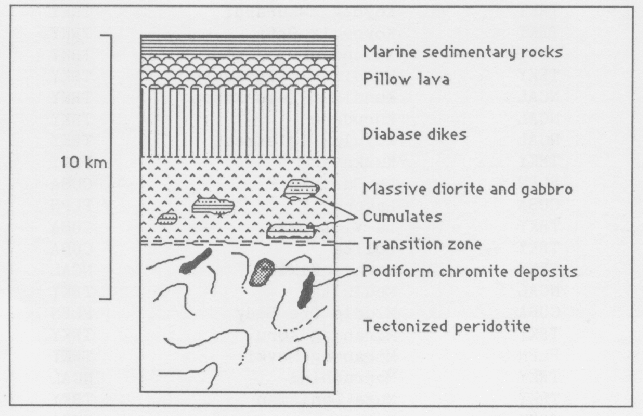
DESCRIPTIVE MODEL OF PODIFORM CHROMITE
MODEL 8a and 8b
By John P. Albers
APPROXIMATE SYNONYM Alpine type chromite (Thayer, 1964).
DESCRIPTION Podlike masses of chromitite in ultramafic parts of ophiolite
complexes (see fig. 20).
Figure 20. Cartoon cross section of a typical ophiolite sequence showing locations of podiform chromite deposits from Dickey (1975).

GENERAL REFERENCE Dickey (1975).
GEOLOGICAL ENVIRONMENT
Rock Types Highly deformed dunite and harzburgite of ophiolite complexes; commonly serpentinized.
Textures Nodular, orbicular, gneissic, cumulate, pull-apart; most relict textures are modified or destroyed by flowage at magmatic temperatures.
Age Range Phanerozoic.
Depositional Environment Lower part of oceanic lithosphere.
Tectonic Setting(s) Magmatic cumulates in elongate magma pockets along spreading plate boundaries. Subsequently exposed in accreted terranes as part of ophiolite assemblage.
Associated Deposit Types Limassol Forest Co-Ni-S-As.
DEPOSIT DESCRIPTION
Mineralogy Chromite ± ferrichromite ± magnetite ± Ru-Os-Ir alloys ± laurite.
Texture/Structure Massive coarse-grained to finely disseminated.
Alteration None related to ore.
Ore Controls Restricted to dunite bodies in tectonized harzburgite or lower portions of ultramafic cumulate (see fig. 99).
Weathering Highly resistant to weathering and oxidation.
Geochemical Signature None recognized.
EXAMPLES
High Plateau, Del Norte Cty, USCA (Wells and others, 1946)
Coto Mine, Luzon, PLPN (LeBlanc and Violette, 1983)